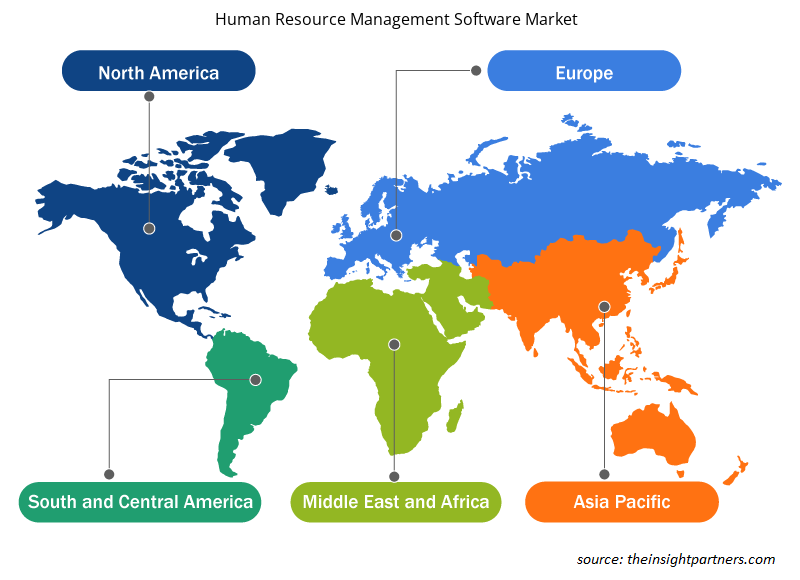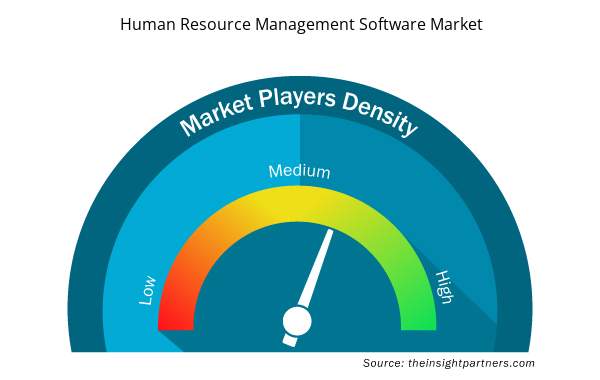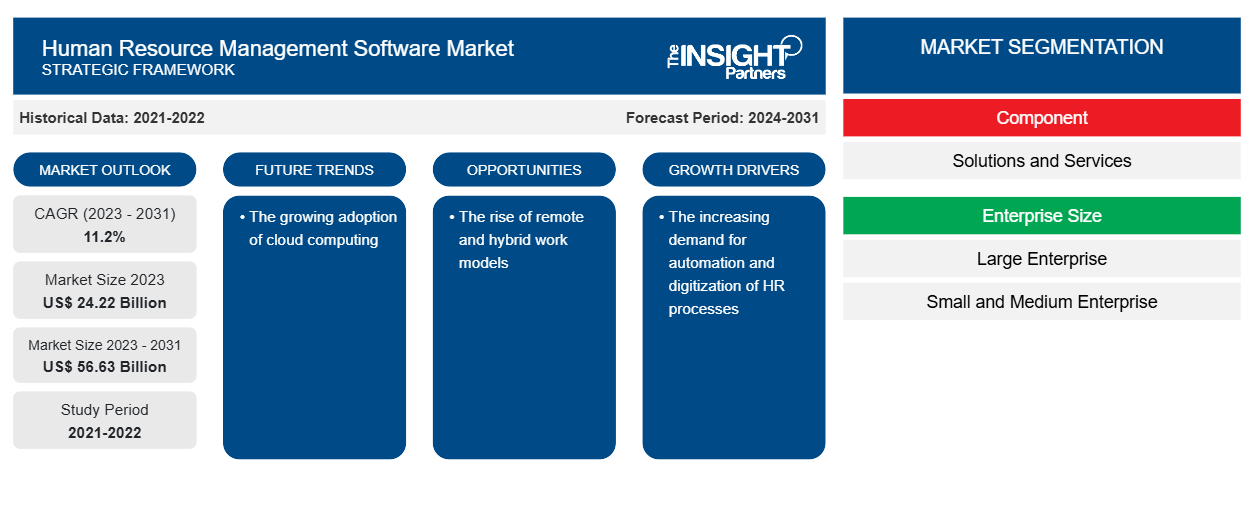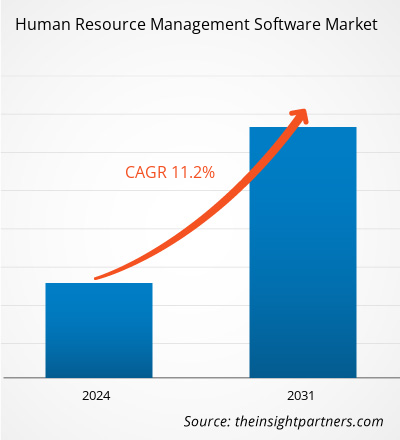Der Markt für Personalmanagementsoftware soll von 24,22 Milliarden US-Dollar im Jahr 2023 auf 56,63 Milliarden US-Dollar im Jahr 2031 anwachsen. Der Markt soll zwischen 2023 und 2031 eine durchschnittliche jährliche Wachstumsrate (CAGR) von 11,2 % verzeichnen. Die zunehmende Nutzung von Cloud Computing dürfte ein wichtiger Trend auf dem Markt für Personalmanagementsoftware bleiben.
Marktanalyse für Personalmanagementsoftware
Es gibt mehrere wichtige Trends auf dem Personalmarkt, wie etwa KI-gesteuerte Analysen für das Talentmanagement, den Aufstieg cloudbasierter HRMS und mobilfreundliche Plattformen für Remote-Arbeitskräfte. Der Markt ist durch einen Fokus auf Benutzererfahrung und intensiven Wettbewerb, Integrationsfähigkeiten und Datensicherheit gekennzeichnet. Da Unternehmen der Produktivität und dem Engagement ihrer Mitarbeiter Priorität einräumen, wird der HRMS-Markt voraussichtlich weltweit weiter wachsen.
Marktübersicht für Personalmanagementsoftware
Software für das Personalmanagement (HRM) modernisiert mehrere HR-Funktionen, um die Effizienz und Effektivität der Mitarbeiterverwaltung zu verbessern. Diese Plattformen umfassen in der Regel Module für die Lohn- und Gehaltsabrechnung, die Anwesenheitsverfolgung, das Leistungsmanagement, die Personalbeschaffung, das Onboarding und den Self-Service für Mitarbeiter. HRM-Software erleichtert auch die Einhaltung von Arbeitsgesetzen und -vorschriften. Zu den wichtigsten Funktionen von HRM-Software gehören häufig robuste Berichts- und Analysefunktionen , um Erkenntnisse aus Personaldaten abzuleiten, die bei der Entscheidungsfindung helfen. Viele Plattformen bieten Cloud-basierte Lösungen, die Fernzugriff und Skalierbarkeit ermöglichen. Zu den beliebten Anbietern von HRM-Software gehören Workday, ADP, BambooHR und SAP SuccessFactors, die jeweils maßgeschneiderte Lösungen für Unternehmen unterschiedlicher Größe und Branche anbieten. Die Implementierung von HRM-Software kann zu einem verbesserten Engagement der Mitarbeiter, einem geringeren Verwaltungsaufwand und optimierten HR-Abläufen führen. Bei der Auswahl der richtigen Software müssen jedoch Faktoren wie Skalierbarkeit, Integrationsmöglichkeiten in vorhandene Systeme und Benutzererfahrung berücksichtigt werden.
Passen Sie diesen Bericht Ihren Anforderungen an
Sie erhalten kostenlos individuelle Anpassungen an jedem Bericht, einschließlich Teilen dieses Berichts oder einer Analyse auf Länderebene, eines Excel-Datenpakets sowie tolle Angebote und Rabatte für Start-ups und Universitäten.
- Holen Sie sich die wichtigsten Markttrends aus diesem Bericht.Dieses KOSTENLOSE Beispiel umfasst eine Datenanalyse von Markttrends bis hin zu Schätzungen und Prognosen.
Treiber und Chancen auf dem Markt für Personalmanagementsoftware
Die steigende Nachfrage nach Automatisierung und Digitalisierung von HR-Prozessen
Da Unternehmen ihre Abläufe rationalisieren und ihre Effizienz verbessern möchten, bietet HRM-Software Lösungen für die Gehaltsabrechnung, das Engagement der Mitarbeiter, die Leistungsbewertung und die Talentakquise. Der Bedarf an zentralisierter Datenverwaltung und -analyse zur Unterstützung strategischer Entscheidungen treibt die Einführung von HRM-Software ebenfalls voran.HRM software offers solutions for payroll management, employee engagement, performance evaluation, and talent acquisition. The need for centralized data management and analytics to support strategic decision-making also propels the adoption of HRM software.
Der Aufstieg von Remote- und Hybrid-Arbeitsmodellen
Mit der Umstellung auf flexible Arbeitsregelungen benötigen Unternehmen HRM-Tools, die die Verwaltung, Zusammenarbeit und Kommunikation von Remote-Mitarbeitern erleichtern. HRM-Software kann ein nahtloses Remote-Onboarding, virtuelle Schulungen und Initiativen zur Mitarbeiterbindung ermöglichen. Während sich Unternehmen an neue Arbeitsparadigmen anpassen, haben Anbieter von HRM-Software die Möglichkeit, Innovationen zu entwickeln und Lösungen anzubieten, die den sich entwickelnden Anforderungen verteilter Teams gerecht werden und so die Produktivität und Mitarbeiterzufriedenheit steigern. Daher wird erwartet, dass der Aufstieg von Remote- und Hybrid-Arbeitsmodellen den Akteuren auf dem Markt für Personalmanagementsoftware im Prognosezeitraum neue Möglichkeiten bietet.HRM tools that facilitate remote workforce management, collaboration, and communication. HRM software can enable seamless remote onboarding, virtual training, and employee engagement initiatives. As businesses adapt to new work paradigms, HRM software providers have the opportunity to innovate and offer solutions that address the evolving needs of distributed teams, enhancing productivity and employee satisfaction. Thus, the rise of remote and hybrid work models is anticipated to present new opportunities for the human resource management software market players during the forecast period.
Segmentierungsanalyse des Marktberichts zur Personalverwaltungssoftware
Wichtige Segmente, die zur Ableitung der Marktanalyse für Personalmanagementsoftware beigetragen haben, sind Komponenten, Unternehmensgröße und Endbenutzer.
- Basierend auf den Komponenten ist der Markt für Personalmanagementsoftware in Lösungen und Dienste segmentiert.
- Nach Unternehmensgröße ist der Markt in Großunternehmen sowie kleine und mittlere Unternehmen segmentiert. Das Segment der Großunternehmen hatte im Jahr 2023 einen größeren Marktanteil.
- Nach Endbenutzer ist der Markt in Bildungseinrichtungen, BFSI, Regierung, Gesundheitswesen, IT und Telekommunikation , Fertigung, Einzelhandel und Sonstiges segmentiert.BFSI, government, healthcare, IT and
Marktanteilsanalyse für Personalmanagementsoftware nach geografischen Gesichtspunkten
Der geografische Umfang des Marktberichts für Personalmanagementsoftware ist hauptsächlich in fünf Regionen unterteilt: Nordamerika, Asien-Pazifik, Europa, Naher Osten und Afrika sowie Südamerika/Süd- und Mittelamerika. In Bezug auf den Umsatz hatte Nordamerika den größten Marktanteil an Personalmanagementsoftware. In Nordamerika, insbesondere in den USA und Kanada, wird das robuste Wachstum von großen Unternehmen vorangetrieben, die integrierte HRM-Suiten für die Talentakquise, das Gehaltsabrechnungsmanagement und die Mitarbeiterbindung einführen.
Regionale Einblicke in den Markt für Personalmanagementsoftware
Die regionalen Trends und Faktoren, die den Markt für Personalmanagementsoftware während des Prognosezeitraums beeinflussen, wurden von den Analysten von Insight Partners ausführlich erläutert. In diesem Abschnitt werden auch Marktsegmente und Geografien für Personalmanagementsoftware in Nordamerika, Europa, im asiatisch-pazifischen Raum, im Nahen Osten und Afrika sowie in Süd- und Mittelamerika erörtert.

- Erhalten Sie regionale Daten zum Markt für Personalmanagementsoftware
Umfang des Marktberichts zur Personalmanagementsoftware
| Berichtsattribut | Details |
|---|---|
| Marktgröße im Jahr 2023 | 24,22 Milliarden US-Dollar |
| Marktgröße bis 2031 | 56,63 Milliarden US-Dollar |
| Global CAGR (2023 - 2031) | 11.2% |
| Historical Data | 2021-2022 |
| Forecast period | 2024-2031 |
| Segments Covered | By Component
|
| Regions and Countries Covered | North America
|
| Market leaders and key company profiles |
|
Human Resource Management Software Market Players Density: Understanding Its Impact on Business Dynamics
The Human Resource Management Software Market market is growing rapidly, driven by increasing end-user demand due to factors such as evolving consumer preferences, technological advancements, and greater awareness of the product's benefits. As demand rises, businesses are expanding their offerings, innovating to meet consumer needs, and capitalizing on emerging trends, which further fuels market growth.
Market players density refers to the distribution of firms or companies operating within a particular market or industry. It indicates how many competitors (market players) are present in a given market space relative to its size or total market value.
Major Companies operating in the Human Resource Management Software Market are:
- Automatic Data Processing, Inc
- SAP SE
- Oracle Corporation
- Workday, Inc
- Ceridian HCM Holding Inc
- Cezanne HR Limited
Disclaimer: The companies listed above are not ranked in any particular order.

- Get the Human Resource Management Software Market top key players overview
Human Resource Management Software Market News and Recent Developments
The human resource management software market is evaluated by gathering qualitative and quantitative data post primary and secondary research, which includes important corporate publications, association data, and databases. The following is a list of developments in the market for speech and language disorders and strategies:
- In April 2023, Pocket HRMS announced the launch of their mission Bharat 2.0 to enable SMEs in India to digitalize their complete HRMS, Payroll system, and related compliances with intuitive and easy-to-use HR software over the WhatsApp messaging platform in regional Indian languages. (Source: Pocket HRMS, Press Release)
- In Jan 2024, OrangeHRM, a leading provider of Human Resource Management solutions, announced the launch of its AI-enabled helpdesk, a groundbreaking addition to its advanced version. Accessible through the HRM help portal, this innovative feature marks a significant milestone in OrangeHRM's commitment to harnessing artificial intelligence to enhance user experience. (Source: OrangeHRM, Press Release)
Marktbericht zu Personalmanagementsoftware – Umfang und Ergebnisse
Der Bericht „Marktgröße und Prognose für Personalmanagementsoftware (2023–2031)“ bietet eine detaillierte Analyse des Marktes, die die folgenden Bereiche abdeckt:
- Marktgröße und Prognose auf globaler, regionaler und Länderebene für alle wichtigen Marktsegmente, die im Rahmen des Projekts abgedeckt sind
- Marktdynamik wie Treiber, Beschränkungen und wichtige Chancen
- Wichtige Zukunftstrends
- Detaillierte PEST/Porters Five Forces- und SWOT-Analyse
- Globale und regionale Marktanalyse mit wichtigen Markttrends, wichtigen Akteuren, Vorschriften und aktuellen Marktentwicklungen
- Branchenlandschaft und Wettbewerbsanalyse, einschließlich Marktkonzentration, Heatmap-Analyse, prominenten Akteuren und aktuellen Entwicklungen
- Detaillierte Firmenprofile
- Historische Analyse (2 Jahre), Basisjahr, Prognose (7 Jahre) mit CAGR
- PEST- und SWOT-Analyse
- Marktgröße Wert/Volumen – Global, Regional, Land
- Branche und Wettbewerbsumfeld
- Excel-Datensatz



Report Coverage
Revenue forecast, Company Analysis, Industry landscape, Growth factors, and Trends

Segment Covered
This text is related
to segments covered.

Regional Scope
North America, Europe, Asia Pacific, Middle East & Africa, South & Central America

Country Scope
This text is related
to country scope.
Häufig gestellte Fragen
The global human resource management software market is expected to reach US$ 56.63 billion by 2031.
The growing adoption of cloud computing is anticipated to play a significant role in the global human resource management software market in the coming years.
The key players holding majority shares in the global human resource management software market are Automatic Data Processing, Inc., SAP SE, Oracle Corporation, Workday, Inc., and Ceridian HCM Holding Inc.
The global human resource management software market was estimated to be US$ 24.22 billion in 2023 and is expected to grow at a CAGR of 11.2 % during the forecast period 2023 - 2031.
The increasing demand for automation and digitization of HR processes and the rise of remote and hybrid work models are the major factors that propel the global human resource management software market.
Trends and growth analysis reports related to Technology, Media and Telecommunications : READ MORE..
The Insight Partners performs research in 4 major stages: Data Collection & Secondary Research, Primary Research, Data Analysis and Data Triangulation & Final Review.
- Data Collection and Secondary Research:
As a market research and consulting firm operating from a decade, we have published and advised several client across the globe. First step for any study will start with an assessment of currently available data and insights from existing reports. Further, historical and current market information is collected from Investor Presentations, Annual Reports, SEC Filings, etc., and other information related to company’s performance and market positioning are gathered from Paid Databases (Factiva, Hoovers, and Reuters) and various other publications available in public domain.
Several associations trade associates, technical forums, institutes, societies and organization are accessed to gain technical as well as market related insights through their publications such as research papers, blogs and press releases related to the studies are referred to get cues about the market. Further, white papers, journals, magazines, and other news articles published in last 3 years are scrutinized and analyzed to understand the current market trends.
- Primary Research:
The primarily interview analysis comprise of data obtained from industry participants interview and answers to survey questions gathered by in-house primary team.
For primary research, interviews are conducted with industry experts/CEOs/Marketing Managers/VPs/Subject Matter Experts from both demand and supply side to get a 360-degree view of the market. The primary team conducts several interviews based on the complexity of the markets to understand the various market trends and dynamics which makes research more credible and precise.
A typical research interview fulfils the following functions:
- Provides first-hand information on the market size, market trends, growth trends, competitive landscape, and outlook
- Validates and strengthens in-house secondary research findings
- Develops the analysis team’s expertise and market understanding
Primary research involves email interactions and telephone interviews for each market, category, segment, and sub-segment across geographies. The participants who typically take part in such a process include, but are not limited to:
- Industry participants: VPs, business development managers, market intelligence managers and national sales managers
- Outside experts: Valuation experts, research analysts and key opinion leaders specializing in the electronics and semiconductor industry.
Below is the breakup of our primary respondents by company, designation, and region:

Once we receive the confirmation from primary research sources or primary respondents, we finalize the base year market estimation and forecast the data as per the macroeconomic and microeconomic factors assessed during data collection.
- Data Analysis:
Once data is validated through both secondary as well as primary respondents, we finalize the market estimations by hypothesis formulation and factor analysis at regional and country level.
- Macro-Economic Factor Analysis:
We analyse macroeconomic indicators such the gross domestic product (GDP), increase in the demand for goods and services across industries, technological advancement, regional economic growth, governmental policies, the influence of COVID-19, PEST analysis, and other aspects. This analysis aids in setting benchmarks for various nations/regions and approximating market splits. Additionally, the general trend of the aforementioned components aid in determining the market's development possibilities.
- Country Level Data:
Various factors that are especially aligned to the country are taken into account to determine the market size for a certain area and country, including the presence of vendors, such as headquarters and offices, the country's GDP, demand patterns, and industry growth. To comprehend the market dynamics for the nation, a number of growth variables, inhibitors, application areas, and current market trends are researched. The aforementioned elements aid in determining the country's overall market's growth potential.
- Company Profile:
The “Table of Contents” is formulated by listing and analyzing more than 25 - 30 companies operating in the market ecosystem across geographies. However, we profile only 10 companies as a standard practice in our syndicate reports. These 10 companies comprise leading, emerging, and regional players. Nonetheless, our analysis is not restricted to the 10 listed companies, we also analyze other companies present in the market to develop a holistic view and understand the prevailing trends. The “Company Profiles” section in the report covers key facts, business description, products & services, financial information, SWOT analysis, and key developments. The financial information presented is extracted from the annual reports and official documents of the publicly listed companies. Upon collecting the information for the sections of respective companies, we verify them via various primary sources and then compile the data in respective company profiles. The company level information helps us in deriving the base number as well as in forecasting the market size.
- Developing Base Number:
Aggregation of sales statistics (2020-2022) and macro-economic factor, and other secondary and primary research insights are utilized to arrive at base number and related market shares for 2022. The data gaps are identified in this step and relevant market data is analyzed, collected from paid primary interviews or databases. On finalizing the base year market size, forecasts are developed on the basis of macro-economic, industry and market growth factors and company level analysis.
- Data Triangulation and Final Review:
The market findings and base year market size calculations are validated from supply as well as demand side. Demand side validations are based on macro-economic factor analysis and benchmarks for respective regions and countries. In case of supply side validations, revenues of major companies are estimated (in case not available) based on industry benchmark, approximate number of employees, product portfolio, and primary interviews revenues are gathered. Further revenue from target product/service segment is assessed to avoid overshooting of market statistics. In case of heavy deviations between supply and demand side values, all thes steps are repeated to achieve synchronization.
We follow an iterative model, wherein we share our research findings with Subject Matter Experts (SME’s) and Key Opinion Leaders (KOLs) until consensus view of the market is not formulated – this model negates any drastic deviation in the opinions of experts. Only validated and universally acceptable research findings are quoted in our reports.
We have important check points that we use to validate our research findings – which we call – data triangulation, where we validate the information, we generate from secondary sources with primary interviews and then we re-validate with our internal data bases and Subject matter experts. This comprehensive model enables us to deliver high quality, reliable data in shortest possible time.


 Holen Sie sich ein kostenloses Muster für diesen Bericht
Holen Sie sich ein kostenloses Muster für diesen Bericht